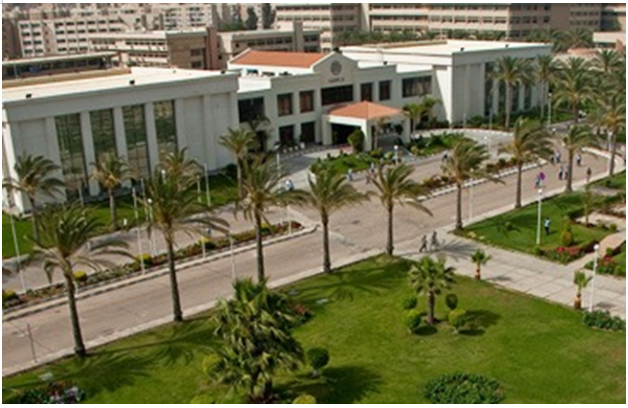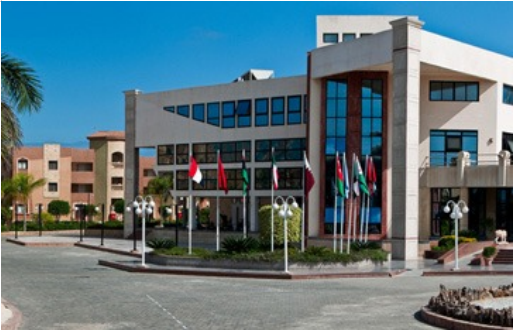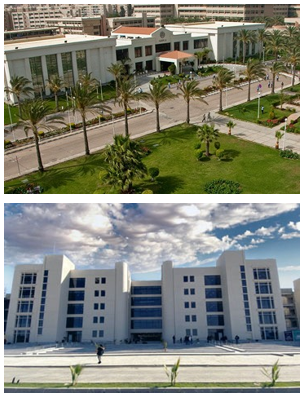 Goal 11. Sustainable Cities and Communities
Goal 11. Sustainable Cities and Communities
11.4.6 "Pedestrian priority on campus
2023 - 2024
AASTMT is actively transforming its campuses into vibrant, pedestrian-centric environments. The commitment to “Prioritise pedestrian access on campus” goes beyond mere policy; it is a core principle of our urban development and urban planning strategy. By prioritizing walking and creating safe, accessible pathways, the campus experience, promoting well-being, and building a sustainable future are enhanced. These initiatives demonstrate a holistic approach to creating a modern city-like campus that values its community and its heritage.
Inauguration of the "Smart Quad" Pedestrian Plaza and The "Green Steps" Campus Mobility Week
In early 2024, AASTMT completed the redevelopment of Abu Qir campus, converting a former access road and parking area into the "Smart Quad," a sprawling pedestrian plaza. This permanent infrastructure project is a testament to our long-term vision for a walkable campus. The plaza creates a seamless and safe connection between the library, engineering facilities, and student life centers, overhauling the previous road network to favor foot traffic. The project incorporates permeable paving to mitigate flood risk during heavy rains, native land cover, and energy-efficient lighting, aligning with broader goals of disaster prevention and sustainability. The plaza's design includes sheltered waiting areas and clear signage.
AASTMT launched its annual "Green Steps" week, a campus-wide initiative encouraging students and staff to choose walking over vehicular transport. This event is a cornerstone of AASTMT strategy to improve the urban landscape and reduce the environmental footprint. This initiative directly prioritizes pedestrian access by temporarily redesigning the campus to be walker-friendly. It serves as a powerful practical experiment in sustainable urban development, showing the immense benefits of reducing vehicular traffic and reclaiming space for people.
Designated Car-Free Zones: Key areas of the campus were designated as pedestrian-only zones, transforming them into vibrant public space hubs for socializing and events. This tactical urban planning initiative drastically reduced traffic noise and improved urban air quality.
Guided Heritage Walks: Students and faculty participated in guided walking tours that showcased the campus's unique architectural and cultural heritage, linking physical activity with an appreciation for our historic buildings and sites.
Intelligent Transportation Showcase: The student projects on smart city technologies for pedestrian safety were presented, including sensor-based crosswalks and apps for mapping the most accessible walking routes, demonstrating a forward-thinking approach to our campus road network.

https://aast.edu/en/research/contenttemp.php?page_id=47300118
AASTMT's Vision for Inclusive, Pedestrian-Centric Smart Campuses
At AASTMT, a university campus is recognized as a microcosm of a city—a living laboratory for sustainable urban planning and urban development. Aligning with the global drive toward smart cities and resilient urbanization, AASTMT is redefining its urban landscape by prioritizing the safety, dignity, and convenience of pedestrians.
AASTMT commitment goes beyond simple aesthetics; it is a strategic implementation of town planning best practices designed to mitigate traffic congestion, reduce pollution, and enhance the quality of public space. By reimagining the road networks, a campus environment is fostered that champions inclusivity, public transport integration, and environmental stewardship. AASTMT is not just building a campus; it sets a benchmark for intelligent transport and sustainable urban land management. AASTMT paves the way for a future where public transportation, walkability, and smart city infrastructure converge to create a thriving, safe, and inclusive community.
AASTMT’s Integrated Strategy for Walkable and Safe Campuses:
To achieve a truly pedestrian-centric environment, AASTMT adheres to rigorous city planning guidelines that separate vehicular traffic from student life, ensuring a safe and accessible street hierarchy. AASTMT approach focuses on the following core pillars:
- Seamless Connectivity and Accessibility: the road network is enhanced to ensure that sidewalks and pathways promote seamless commuting between academic buildings, parks, and facilities. This design supports residential mobility within the campus and encourages walking as a primary mode of transit.
- Safety via Intelligent Design: Utilizing principles of intelligent transportation and traffic signal optimization, safe pedestrian crossings are implemented that minimize conflict points between walkers and vehicles, thereby reducing the risk of accidents and traffic noise.
- Pedestrian-Friendly Design: The campus regeneration efforts focus on creating a comfortable atmosphere. This includes shading to combat urban heat and heat island effects, ensuring that walking is a viable and pleasant option year-round.
- Separation from Vehicle Traffic: By delineating distinct zones for transportation systems and pedestrians, AASTMT prioritize human movement over highway traffic. This separation is crucial for disaster prevention and ensures unobstructed access for emergency services.
- Universal Accessibility: True to the spirit of inclusive housing and community, AASTMT pathways are designed to be fully accessible for people with disabilities. Any barriers are removed to ensure that the public spaces are equitable for all, reflecting the social heritage of our diverse academic community.



2022 - 2023
Paving the Way for Pedestrian-Centric Campuses: AASTMT's Commitment to Walkable, Inclusive Spaces
AASTMT considers the safety and convenience of pedestrians. AASTMT campuses follow the guidelines on prioritizing pedestrian access based on best practices and urban design principles. These guidelines are:
- Sidewalk Connectivity and Accessibility
- Safe Pedestrian Crossings
- Pedestrian-Friendly Design
- Separation from Vehicle Traffic
- Accessibility for People with Disabilities.


https://aast.edu/en/campuses/Elalamein/
https://aast.edu/en/campuses/portsaid/
Empowering Inclusion: AASTMT's Commitment to Accessible, Barrier-Free Campuses
AASTMT is making continuous efforts to enable students with disabilities to easily access the campus and there are ongoing efforts to provide an inclusive university environment that is accessible to everyone by providing support and facilities to students with disabilities to ensure their access to the campus and benefit from educational opportunities to the same extent such as other students.

2021 - 2022
Prioritise Pedestrian Access on Campus
AASTMT considers the safety and convenience of pedestrians. AASTMT campuses follow the guidelines on prioritizing pedestrian access based on best practices and urban design principles. These guidelines are:
- Sidewalk Connectivity and Accessibility
- Safe Pedestrian Crossings
- Pedestrian-Friendly Design
- Separation from Vehicle Traffic
- Accessibility for People with Disabilities.
The Transport Department of the Arab Academy offers a distinctive transportation service to transport our students and working on a fleet of bus with the latest technical means. All bus has free Wi-Fi service and all vehicles have GPS devices that make the service safer to locate and move all vehicles to ensure the safety of passengers during daily trips. Transport service covers all regions.
Prioritize pedestrian access on campus on AASTMT page


